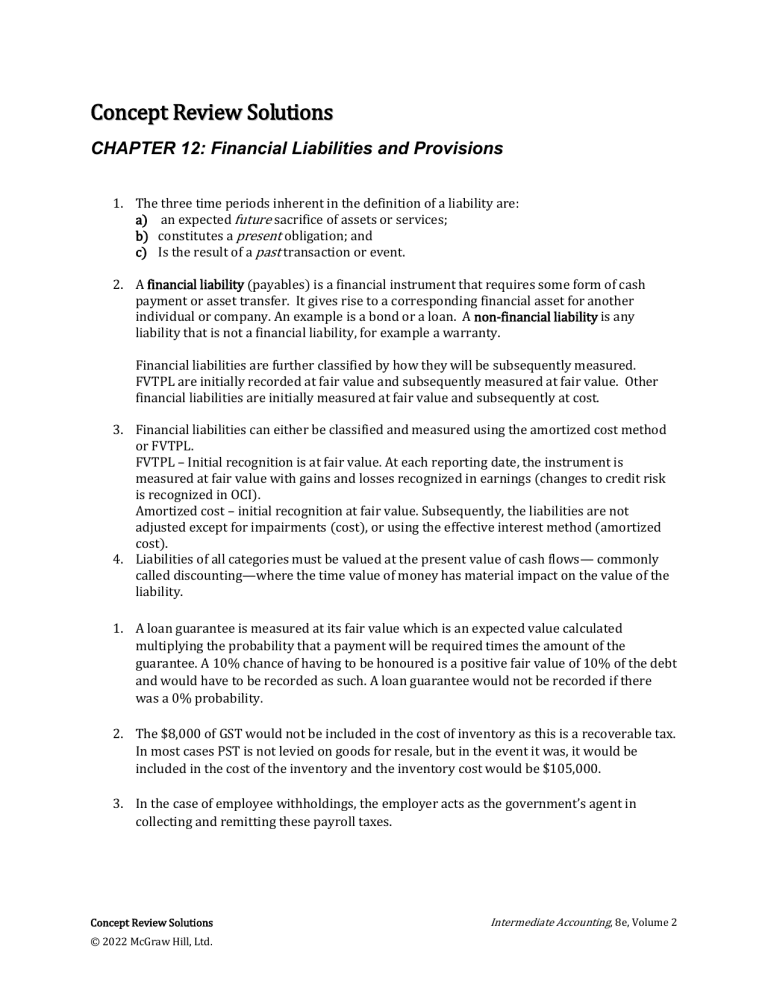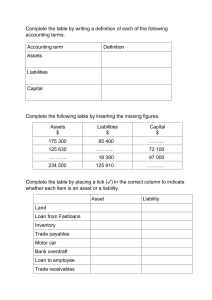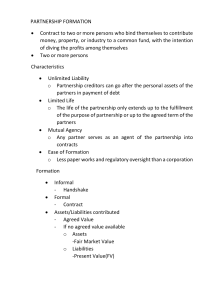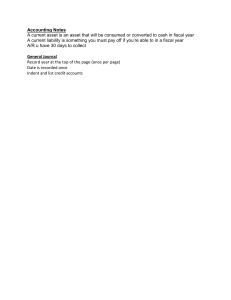Financial Liabilities & Provisions Concept Review Solutions
advertisement

Concept Review Solutions CHAPTER 12: Financial Liabilities and Provisions 1. The three time periods inherent in the definition of a liability are: a) an expected future sacrifice of assets or services; b) constitutes a present obligation; and c) Is the result of a past transaction or event. 2. A financial liability (payables) is a financial instrument that requires some form of cash payment or asset transfer. It gives rise to a corresponding financial asset for another individual or company. An example is a bond or a loan. A non-financial liability is any liability that is not a financial liability, for example a warranty. Financial liabilities are further classified by how they will be subsequently measured. FVTPL are initially recorded at fair value and subsequently measured at fair value. Other financial liabilities are initially measured at fair value and subsequently at cost. 3. Financial liabilities can either be classified and measured using the amortized cost method or FVTPL. FVTPL – Initial recognition is at fair value. At each reporting date, the instrument is measured at fair value with gains and losses recognized in earnings (changes to credit risk is recognized in OCI). Amortized cost – initial recognition at fair value. Subsequently, the liabilities are not adjusted except for impairments (cost), or using the effective interest method (amortized cost). 4. Liabilities of all categories must be valued at the present value of cash flows— commonly called discounting—where the time value of money has material impact on the value of the liability. 1. A loan guarantee is measured at its fair value which is an expected value calculated multiplying the probability that a payment will be required times the amount of the guarantee. A 10% chance of having to be honoured is a positive fair value of 10% of the debt and would have to be recorded as such. A loan guarantee would not be recorded if there was a 0% probability. 2. The $8,000 of GST would not be included in the cost of inventory as this is a recoverable tax. In most cases PST is not levied on goods for resale, but in the event it was, it would be included in the cost of the inventory and the inventory cost would be $105,000. 3. In the case of employee withholdings, the employer acts as the government’s agent in collecting and remitting these payroll taxes. Concept Review Solutions © 2022 McGraw Hill, Ltd. Intermediate Accounting, 8e, Volume 2 1. When the capital asset is acquired it is recorded at the exchange rate in effect at the time (100,000 x 2.10= $210,000 Cdn). Subsequent changes in exchange rate lead to exchange gains or losses on the payment. 2. A liability exists when it is deducted from an employees’ pay as this money is owed to the federal and provincial government. 1. Inventory is recorded at the amount using the spot rate on the date of purchase. 2. The capital asset would be recorded at $210,000 (100,000 x $2.10). 3. There would be an exchange gain of $15,000. (100,000 x (2.10-1.95)). On the date of purchase: Dr. Capital Asset 210,000 Cr. Accounts payable 210,000 When the balance is paid: Dr. Accounts payable Cr. Cash Cr. Foreign exchange gain 210,000 195,000 15,000 1. A provision is defined as a liability of uncertain timing or amount. If here is sufficient certainty the liability is recorded for a provision. In the case of a contingency the likelihood of a liability falls beneath the threshold to be recorded. 2. A provision is recorded at the best estimate of the expenditure required to settle the present obligation – the expected value. In a large population this would be a statistical product of the possible outcomes and their probabilities. In a small population, judgment would be applied to obtain the best estimate. 3. These would not be discounted if the amount and timing of cash flows is highly uncertain. 4. Virtually certain is a much higher degree of certainty compared to probable. It means that the amount is going to be paid. Probable has a lower degree of certainty, but given the balance of facts there is a strong chance that it will be paid. 1. If the unavoidable costs of meeting a contract exceed the economic benefits under the contract, then the contract is classified an onerous contract. An example is when a company has vacated leased premises, but must continue to make payments on the lease until it matures. This contract is now onerous since there are no benefits to be received from these payments. Concept Review Solutions © 2022 McGraw Hill, Ltd. Intermediate Accounting, 8e, Volume 2 2. A warranty is either a legal or constructive obligation providing assurance that a product will operate to meet specifications. While there is uncertainty concerning the amount or timing of providing services under the warranty a provision can be recorded. 3. A provision for coupons is recorded when the coupon results in either a payment of cash (to the retailer or customer) or the product is sold at a loss, and the company cannot cancel the coupon at any time. 4. A provision for losses arising from self-insurance is recorded when a loss event has arisen prior to the reporting date even if the loss event is not yet known. A provision cannot be made for self-insurance for future events. When comparing to the definition of a liability, it makes sense that you cannot recognize a liability for self-insurance relating to a future event as liabilities must be a present obligation for a past event. 1. When an asset is acquired and all or part of the consideration is debt at a low rate of interest or no interest, then the cost of the asset will be reduced to reflect the fair value of the low-cost debt. This would be discounted using an interest rate equivalent to the current market rate. 2. Discounting is the practice of revaluing future cash flows to reflect time and interest. The difference in the nominal value of cash flows and the discounted values of the cash flows is referred to as the discount. Over time this discount is amortized to reflect the effective interest cost of the transaction so to speak it is unwound. 3. The interest rate used to discount a low-interest note payable would be the equivalent rate that the party would experience to finance a similar transaction in the market place at arm’s lengththe market rate. 4. When an estimate changes for an environmental provision, interest for the year is first recorded using the estimates from the beginning of the period, i.e. before any changes. Then any adjustments required due to changes in estimates are recorded to the asset and decommissioning liability account. Interest expense is not impacted in the year of change. Concept Review Solutions © 2022 McGraw Hill, Ltd. Intermediate Accounting, 8e, Volume 2








